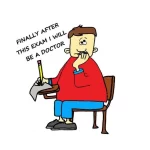
This post is for the 4th year B.H.M.S. students preparing for PRACTICE OF MEDICINE PAPER-1 as per the Exam Syllabus.
It contains almost all the topics along with their most important and frequently asked questions in different Indian university examinations.
STUDY OF PRACTICE OF MEDICINE
The study of the Practice of medicine will be done in two years in Third B.H.M.S. and Fourth B.H.M.S., but examination will be conducted at the end of Fourth B.H.M.S. (There will be No exam in 3rd B.H.M.S. for this subject).
THIRD B.H.M.S. TOPICS
- Respiratory diseases.
- Diseases of digestive system and peritoneum.
- Diseases concerning liver, gall-bladder and pancreas.
- Genetic Factors (co-relating diseases with the concept of chronic Miasms).
- Immunological factors in diseases with concept of susceptibility (including HIV, Hepatitis).
- Disorders due to chemical and physical agents and due to climatic and environmental factors.
- Water and electrolyte balance – disorders of.
FOURTH B.H.M.S. TOPICS
- Nutritional and metabolic diseases
- Diseases of haemopoietic system.
- Endocrinal diseases.
- Infectious diseases.
- Diseases of cardiovascular system.
- Diseases of urogenital tract.
- Disease of CNS and peripheral nervous system.
- Psychiatric disorders.
- Diseases of locomotor system (connective tissue, bones and joints disorders)
- Diseases of skin and sexually transmitted diseases.
- Tropical diseases.
- Paediatric disorders.
- Geriatric disorders.
Applied anatomy, applied physiology and knowledge of clinical examination of above-mentioned topics.
Table of Contents
ToggleTHEORY EXAMINATION
Number of papers – 02
Marks: Paper 1-100 marks; Paper 2-100 marks.
Paper-1
- Section A: Topics of 3rd B.H.M.S. – 50 marks
- Section B: Homoeopathic Therapeutics related to topics of 3rd B.H.M.S. – 50 marks
Paper- 2
- Section A: Topics of 4th B.H.M.S. – 50 marks
- Section B: Homoeopathic Therapeutics related to topics of 4th B.H.M.S. – 50 marks
The Paper 1 and Paper 2 divisions have been prepared on the basis of syllabus of B.H.M.S. (Degree course) applicable from the academic session 2015-2016, as per guidelines of Central Council of Homoeopathy.
This post contains only the syllabus of Practice of medicine Paper 1.
The syllabus for Practice of medicine Paper 2 is given in a separate post 4th B.H.M.S. PRACTICE OF MEDICINE PAPER-2 EXAM SYLLABUS
All the important questions are given under their related chapters.
- FQ: Full Question
- SFQ: Semi Full Question
- SN: Short Note
SECTION A (TOPICS OF 3rd B.H.M.S.)
RESPIRATORY TRACT
- FQ: Bronchial asthma
- FQ: Bronchiectasis
- FQ: Bronchitis (Acute and Chronic)
- FQ: Bronchogenic carcinoma
- FQ: Chronic bronchitis
- FQ: COPD/ Chronic Obstructive Pulmonary Disease
- FQ: Emphysema
- FQ: Pleurisy
- FQ: Pneumonia (Especially acute lobar pneumonia)
- FQ: Pulmonary tuberculosis
- SFQ: Common manifestations of respiratory diseases
- SFQ: Laryngitis (Acute and Chronic)
- SFQ: Pleural effusion
- SFQ: Sarcoidosis
- SFQ: Spontaneous pneumothorax
- SN: Acute coryza
- SN: Acute Respiratory Failure/ARF
- SN: Acute sinusitis
- SN: Chyne-stroke breathing
- SN: Cor Pulmpnale (Pulmonary heart disease)
- SN: Cyanosis
- SN: Difference between Bronchial asthma and Cardiac asthma
- SN: Difference between Broncho pneumonia and Lobar pneumonia
- SN: Difference between COPD and Asthma
- SN: Difference between Haemoptysis and Haematemesis
- SN: Difference between Pulmonary tuberculosis and Bronchiectasis
- SN: Dyspnoea
- SN: Empyema/Thoracis/Pyrothorax
- SN: Epistaxis
- SN: Haemoptysis
- SN: Laryngeal obstruction
- SN: Lung abscess
- SN: Miliary tuberculosis
- SN: Pneumoconiosis
- SN: Pulmonary embolism and infarction
- SN: Pulmonary fibrosis
- SN: Pulmonary hypertension
- SN: Pulmonary oedema
- SN: SARS Coronavirus/ Severe Acute Respiratory Syndrome
DIGESTIVE TRACT AND PERITONEUM
- FQ: Acute abdomen
- FQ: Chronic duodenal ulcer
- FQ: Peptic ulcer
- SFQ: Ascites
- SFQ: Differential diagnosis of Chronic gastric ulcer, Chronic duodenal ulcer and Gastric cancer
- SFQ: Gastric cancer
- SFQ: Gastroesophageal Reflux Disease (GERD)
- SFQ: Stomatitis
- SFQ: Ulcerative colitis
- SN: Achalasia cardia/Cardiospasm
- SN: Acute gastritis
- SN: Anal fissure
- SN: Anal fistula
- SN: Chronic diarrhoea
- SN: Chronic gastric ulcer
- SN: Crohn’s disease
- SN: Difference between Amoebic and Bacillary dysentery
- SN: Diverticulitis
- SN: Dysentery
- SN: Dysphagia
- SN: Gastralgia
- SN: Glossitis (Inflammation of tongue)
- SN: Haematemesis and melaena
- SN: Heartburn/waterbrash
- SN: Hiatus hernia
- SN: Intestinal tuberculosis
- SN: Irritable Bowel Syndrome (IBS)
- SN: Zollinger-Ellison Syndrome (ZES)
LIVER, GALL-BLADDER AND PANCREAS
- FQ: Acute type A hepatitis/Acute viral hepatitis
- FQ: Cirrhosis of liver/Portal cirrhosis
- FQ: Jaundice
- FQ: Liver abscess
- SFQ: Acute pancreatitis
- SFQ: Differential diagnosis of jaundice (Haemolytic, Hepatogenous or Obstructive)
- SN: Acute type B hepatitis
- SN: Difference between Infective hepatitis and Amoebic hepatitis
- SN: Hepatic coma/Liver failure
- SN: Hepatomegaly
- SN: Liver Function Tests
- SN: Portal hypertension
- SN: Pyloric obstruction

GENETIC DISORDERS
- SN: Argyl Robertson pupils
- SN: Congenital syphilis
- SN: Down’s syndrome/Trisomy 21
- SN: Holt Oram syndrome
- SN: Laurence Moon-Berdet-Bledl syndrome (LMBBS)
- SN: Wilson’s disease
DISORDERS DUE TO CHEMICAL AND PHYSICAL AGENTS
- SN: Asbestosis
- SN: Contact dermatitis
- SN: Pneumoconiosis
- SN: Silicosis
DISEASES DUE TO CLIMATIC AND ENVIRONMENTAL FACTORS
- SN: Heat hyperpyrexia/Heat stroke
- SN: Hypothermia
- SN: Raynaud’s syndrome
- SN: Tropical Eosinophilia/Weingarten’s syndrome/Eosinophilic lung
- SN: Ultraviolet radiation
DISORDERS OF WATER AND ELECTROLYTE IMBALANCE
- SN: Dehydration
- SN: Hyperkalaemia
- SN: Hypokalaemia
- SN: Hyponatremia
SECTION B (HOMOEOPATHIC THERAPEUTICS)
The word Therapeutic means treatment of the disease by application of medicinal substance.
Homoeopathic therapeutics means application of remedial agents on the basis of symptoms similarity.
- The answer of homoeopathic management (therapeutics) includes the homoeopathic medicines with their indications related to that particular disease condition.
RESPIRATORY TRACT DISEASES
- Coryza: ACONITE, ALLIUM CEPA, ARS ALB, MERC SOL, PULS, SULPHUR
- Acute bronchitis: ACONITE, BELLADONNA, IPECAC, RUMEX, FERRUM PHOS, SILICEA
- Chronic bronchitis: BRYONIA, CAUSTICUM, RHUS TOX, PHOSPHORUS
- Bronchiectasis: ARS ALB, SULPHUR, IPECAC, CUPRUM, FERR PHOS, KALI PHOS, KALI MUR
- Bronchial asthma/Tropical eosinophilia: IPECAC, ARSENIC, FERRUM PHOS, KALI CARB
- Pneumococcal pneumonia (Acute lobar pneumonia): ANTIM TART, PHOS, IPECAC, SANGUINARIA, FERR PHOS, KALI MUR, KALI SULPH
- Acute broncho-pneumonia: FERRUM PHOS, KALI MUR, CALC SULPH
- Pleurisy/pleural effusion: BRYONIA, PHOSPHORUS, SQUILLA, ACONITE, FERR PHOS, CALC PHOS, CALC SULPH
- Empyema: MERCURIUS, BRYONIA, SANGUINARIA, TERT EM, FERR PHOS, KALI MUR, CALC SULPH
- Spontaneous pneumothorax: BRYONIA, KALI CARB, SQUILLA, ARS ALB, FERR PHOS, KALI SULPH, NAT SULPH
- Emphysema: CUPRUM MET, BELLADONNA, NAT MUR, SULPHUR, FERR PHOS, NAT MUR, SILICEA
- Bronchogenic carcinoma: HYDRASTASIS, CONDURANGO, NITRIC ACID, CALC FLUOR, KALI SULPH, CALC PHOS
- Haemoptysis/Epistaxis: IPECAC, HAMAMELIS, CHINA, MILLEFOLIUM, FERR PHOS, KALI PHOS, KALI MUR, NAT MUR
- Lung abscess: SILICEA, SULPHUR, HEPAR SULPH, FERRUM PHOS, KALI MUR
- Pulmonary tuberculosis/Miliary TB: ARSENIC ALB, NITRIC ACID, PHOS, SULPHUR, FERR PHOS, CALC PHOS, NAT MUR
GASTROINTESTINAL TRACT
- Stomatitis: BORAX, NIT ACID, MERC, MURIATIC ACID, BAPTISIA, NUX VOM, SULPH ACID, KALI CHLOR
- Dysphagia: COLCHICUM, MERCURIUS, SILICEA, CONIUM
- Hiatus hernia: ARSENIC, BELLADONNA
- Diarrhoea: VERAT ALB, PODOPHYLLUM, ALOE SOCOTRINA, ARS ALB, SULPHUR
- Bacillary dysentery: MERC COR, MERC SOL, NITRIC ACID, NUX VOMICA, FERRUM PHOS, KALI PHOS, MAG PHOS, KALI MUR
- Amoebic dysentery: ACONITE, IPECAC, ALOES, PODOPHYLLUM, PULSATILLA, FERRUM PHOS, KALI PHOS, MAG PHOS, KALI MUR
- Haematemesis/Melaena: HAMAMELIS, IPECAC, PHOSPHORUS, CHINA
- Ulcerative colitis: LACHESIS, MERC SOL, ARS ALB, NUX VOM
- Piles/Hemorrhoids: SULPHUR, NUX VOMICA, PULS, CARBO VEG, CAPSICUM, BRYONIA, RATANHIA, ALOS SOCOTRINA
- Ascites: APIS MEL, ACETIC ACID, GRAPHITES, LYCOPODIUM
- Constipation: ALUMINA, BRYONIA, CALC CARB, GRAPH, LYCO, NAT MUR, KALI CARB, NUX VOM, OPIUM
- Anal fissure: CHAM, GRAPH, NIT ACID, RATANHIA, SEPIA, THUJA
- Anal fistula: AUR MUR, BERB, CALC, CALC PHOS, CARBO VEG, CARC, CAUST, KALI CARB, NIT ACID
- Peptic ulcer: ARG NIT, ARS ALB, NIT ACID, NUX VOM, ROBINIA, ANACARDIUM, CARBO VEG, COLOCYNTH, MAG PHOS, LYCOPODIUM
- Gastric cancer: CONIUM, CONDURANGO, HYDRASTIS
LIVER, GALL-BLADDER AND PANCREAS
- Acute type A hepatitis/Viral hepatitis: BRYONIA, CHAMOMILLA, CHELIDONIUM, NUX VOM, NAT PHOS, CALC SULPH, KALI MUR
- Cirrhosis of liver: NAT PHOS, LYCO, HYDROCORTYLE, CARBO VEG, NAT SULPH, CALC SULPH, KALI MUR
- Liver abscess: SILICEA, NAT SULPH, NAT PHOS
- Jaundice: CHELIDONIUM, BRYONIA, NUX VOM, MERCURIUS, PODO, KALI MUR, NAT MUR, KALI SULPH
- Acute pancreatitis: CONIUM, IODUM, IRIS VERS, BELLADONNA
Hope that you find this post helpful for your upcoming examinations.
You may also find useful content of other subjects of 4th B.H.M.S. by following the below mentioned links,
















Tq soo much
Your welcome Saundarya…
Tqsm mam for all the homoeopathy things
Thank you so much 🤟
Thanks to the efforts. Very helpful. Amazing Collections of Important Questions. Examination Saviour. May God Bless. If Possible Solve the relevant answers for Future Students.